Setting up a bearded dragon habitat can seem like a daunting task – after all, there are a lot of different things to consider. Tank size, lighting, decoration, and so much more.
In reality, recreating the desert habitat of the bearded dragon can be done easily and inexpensively even if you have no prior experience.
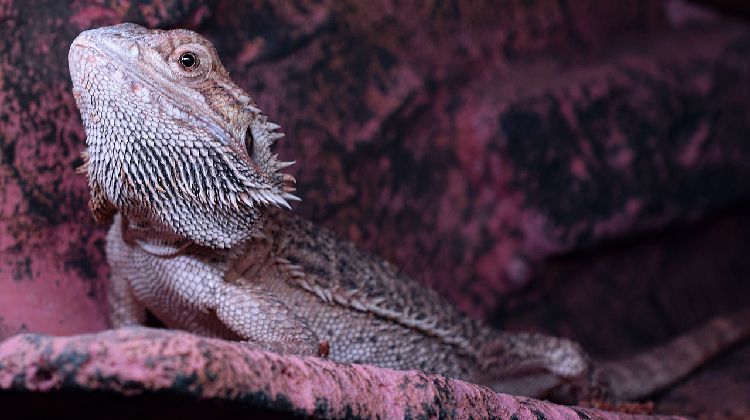
In this guide, we cover everything you need to know about putting together the perfect bearded dragon tank. Raising bearded dragons no longer has to be so hard!
Quick Navigation
Choosing a Bearded Dragon Habitat
The most popular choice of enclosure for bearded dragons in a simple aquarium. Bare aquariums are relatively cheap, easy to clean, and work perfectly for bearded dragons.
Size
Size is the most important factor when selecting a bearded dragon tank. Many people choose to start out their bearded dragon in a small tank – in my opinion, this is a mistake.
It’s better and cheaper in the long run to just shell out the cash for a tank that won’t need to be ungraded.
Here is a quick guide to choosing the correct size tank for you bearded dragon:
- Babies: 20 gallons, 30″ x 12″ x 12″
- Juveniles: 40 gallons, 36″ x 18″ x 16″
- Adults: 125 gallons, 48″ x 24″ x 24″
When it comes to the layout, length and width are more important than height. Since bearded dragons usually aren’t avid climbers, unnecessarily tall talks are kind of “wasted” space.
Material
Like we covered above, glass aquariums are usually the go-to choice of enclosure. That said, some people like to build their own setups out of wood.
If you decide to put together a DIY out of wood, make sure that you watch your temperature levels.
Wood tends to retain heat better than glass, so temperatures may sit a little higher than you would expect.
Bearded Dragon Substrates
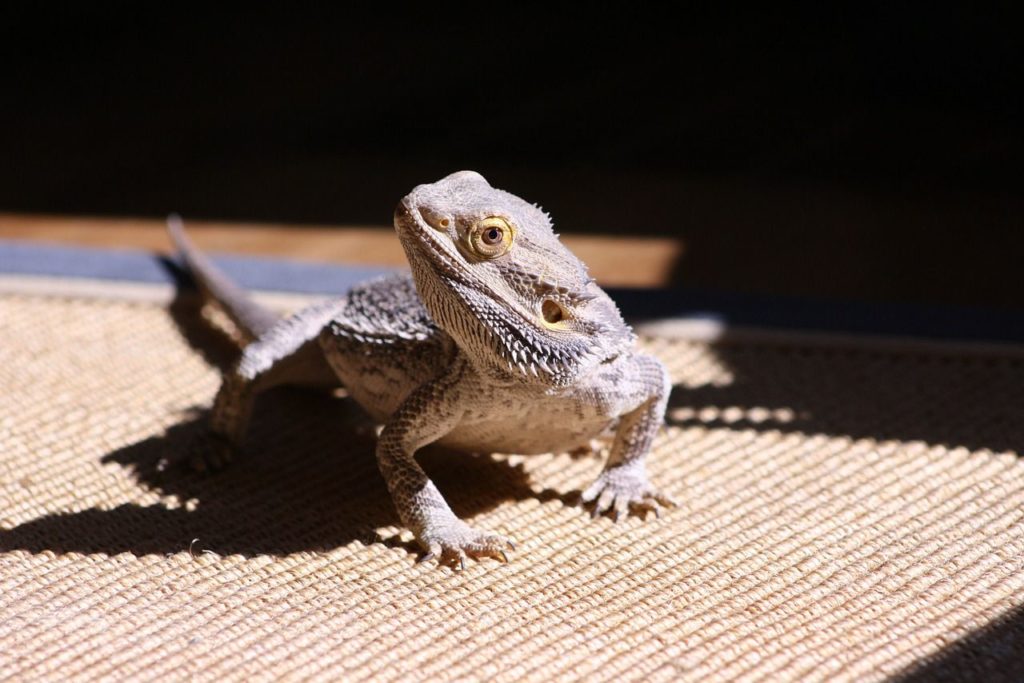
Your Bearded Dragon is going to spend a healthy amount of time digging and rummaging around in the habitat’s substrate.
When choosing a material for the substrate you should follow these basic guidelines:
- Cost: Cheap is the way to go here. You’re going to use up a ton of this material of your pet’s lifespan, so burning through cash doesn’t make much sense when it comes to the substrate for your bearded dragon’s habitat.
- Absorption: The substrate should be highly absorbent. If not, you’ll be cleaning and replacing other materials in the habitat far more often than should be necessary.
- Edible: Bearded Dragons love to dig. They’re going to dig into the substrate, and they’re going to end up eating some of it—there’s no real way to prevent this completely. Make sure the material is digestible so that it doesn’t create a health emergency when swallowed.
- Hygienic: The substrate material must be easy to clean. This will help keep your little guy (or gal) healthy and happy.
Our substrate of choice for bearded dragons is Zilla Reptile Carpet. It is cheap, easy to clean, and 100% safe for bearded dragons.
Some other great substrate choices are non-adhesive shelf liner, ceramic tiles, paving stones, and newspaper. Whatever you decide to use, make sure you avoid any type of particle substrate. Substrates such as sand, gravel, and mulch are known to cause impaction, which can lead to death.
The Habitat’s Landscape
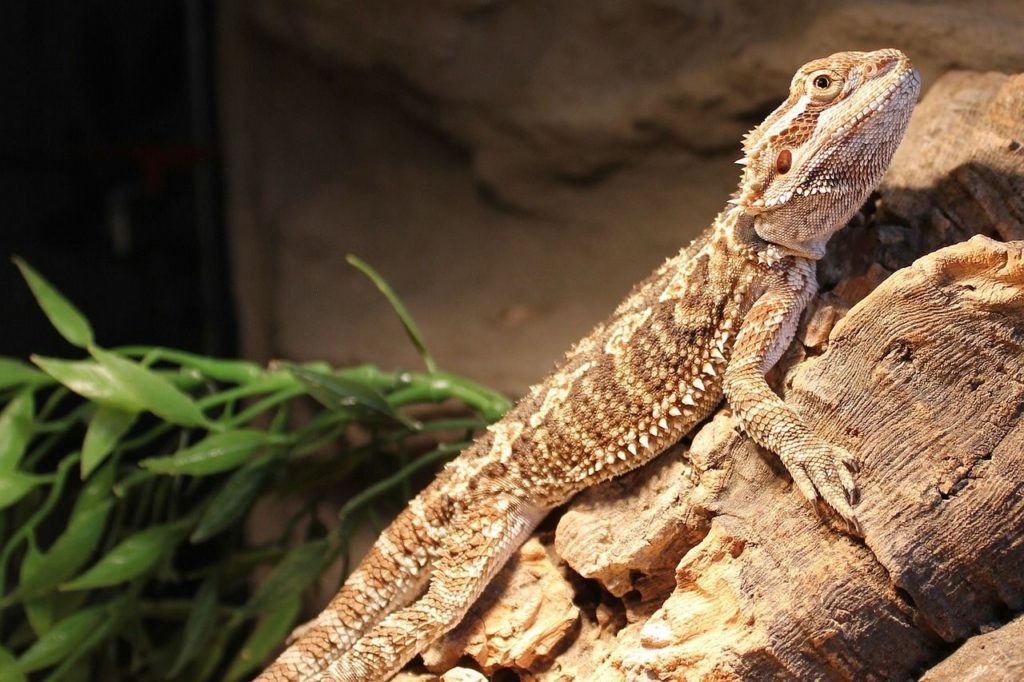
Your Bearded Dragon is going to spend a substantial amount of time climbing in addition to all their digging. Branches should be positioned throughout the enclosure allowing your pet can reach different sections of the habitat’s heat gradient.
Branches should also be dry (no sap), sturdy, and large enough (wide enough) to support your Bearded Dragon.
You should also provide a reptile hide for your bearded dragon. It may be necessary to change the item used for this hiding place as the dragon grows, due to the glove-like fit it should provide when they are nestled inside of it.
If your pet doesn’t seem interested in their hiding place, try switching its location around until you’ve found the sweet spot.
Plant life should be non-toxic and provide a shaded region of the habitat. No matter where you purchase the plants, wash them thoroughly with water as to remove any pesticide they may be coated with.
It is important not to overlook the fact that the habitat enclosure and contents should be as aesthetically pleasing to your Bearded Dragon as possible. You must replicate a natural Bearded Dragon habitat as closely as possible.
Check out our guide on the best bearded dragon plants if you’re interested in added natural plant life. Make it homey!
Bearded Dragon Lighting
There are two main components that are absolutely essential when it comes to lighting your bearded dragon tank – a UVB bulb and a basking lamp.
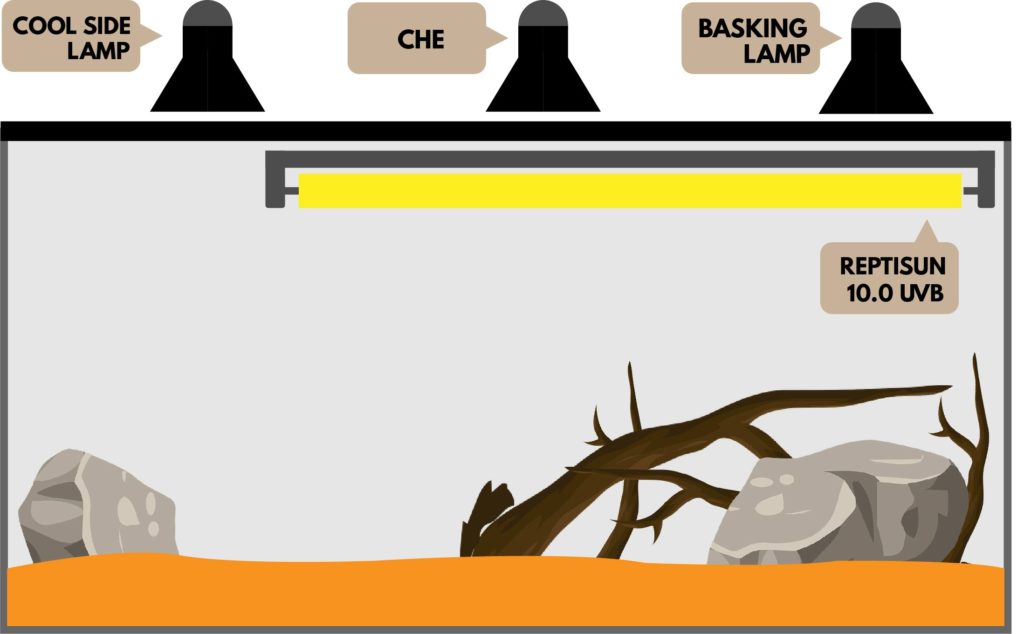
UVB Lighting
UVB lighting is arguably the most important part of any bearded dragon setup. Without it, bearded dragons develop something called Metabolic Bone Disease – a painful and fatal condition that causes bone deformation (and eventually, death).
The ZooMed 10.0 UVB Lamp is widely considered the go-to pick for bearded dragons. Make sure you use the tube version, not the compact version.
Compact fluorescent bulbs can be harmful on the eye’s of your reptile, which is why we recommend using the tube version.
The Basking Lamp
The basking bulb’s main purpose is to generate heat help you bearded dragon regulate its body temperate. The basking lamp should be places all the way towards one side of the setup so you bearded dragon escape the heat when it wants to cool off.
Although there are tons of “reptile” basking bulbs out there, I’ve found that a simple halogen bulb/floodlight tends to work the best.
Don’t waste you money buying a specialty basking bulb.
It may also be necessary to purchase a ceramic heat emitter (CHE) for nighttime heating if you live in an area where temperatures drop below a suitable minimum after nightfall.
We recommend the Fluker’s Ceramic Reptile Heat Emitter.
Overall, setting up lighting for a bearded dragon tank can be a bit complicated. For more detailed instructions about lighting your bearded dragon’s enclosure, check out our complete bearded dragon lighting guide.
Humidity
Proper humidity levels are necessary for your Bearded Dragon to maintain an adequate quality of life. Without appropriate humidity a Bearded Dragon is also unable to shed properly.
Be sure to mist your dragon weekly (at least once) as well as the plant life in the habitat. Adjust the frequency of these misting accordingly for seasonal changes in humidity levels.
Make sure that your Bearded Dragon has access to a shallow “soaking tub” that is easy for them to climb in and out of.
Remember to change the water regularly as soaking will stimulate the passing of bodily waste.
Purchasing a hygrometer will allow you to pin point the “sweet spot” for habitat humidity (35-40%).
We recommend the Zoo Med 2-in-1 Digital Thermometer and Humidity Gauge.
Cleaning the Habitat
Bleach is the cleaning solution of choice for the cage and its inorganic contents.
THE BLEACH MUST BE HEAVILY DILUTED BEFORE USE, WITH AN IDEAL RATION BEING 1:10 (BLEACH:WATER) OR SLIGHTLY BELOW.
The cage and its contents should be cleaned on a regularly basis; it is recommended to perform these cleanings at least weekly.
There is no such thing as being “too thorough” when it comes to rinsing off the enclosure and its contents after they’ve come into contact with bleach. Even a thin film left behind can become majorly problematic for your Bearded Dragons skin and respiratory system; this is amplified further once the heating element is reintroduced to the habitat.
Check, double check, and triple check for residue left behind by any cleaning solutions! Remove anything left behind before you put your bearded dragon back into its enclosure.
Mixing of Sexes
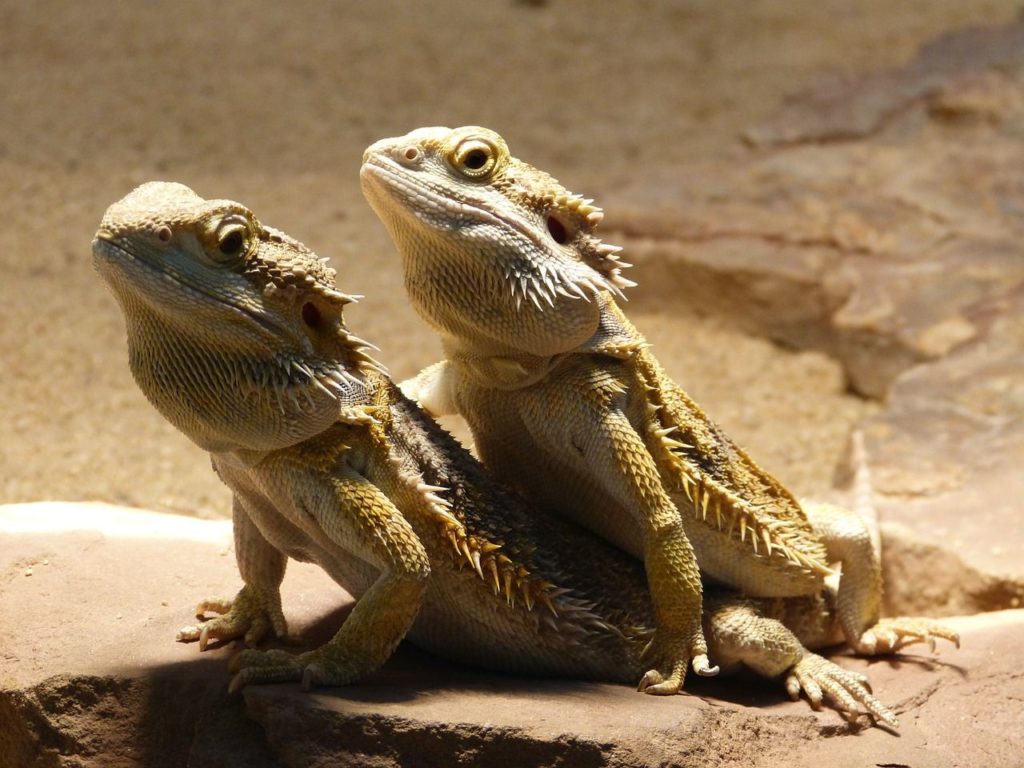
Bearded Dragons enjoy their personal space. Male Bearded Dragons are especially prone to becoming fiercely territorial.
It follows that you should not ever, ever keep more than one male in an enclosure. It will be impossible to prevent the animals from harming one another at some point.
Keeping more than one female together could be possible, but the same development of periodic territorial behavior is almost inevitable.
A male and female pairing is another possibility, but the obvious issue here is the potential for them to reproduce. If you don’t intend to breed Bearded Dragons you should avoid keeping a male and female in the same enclosure.
The territorial behavior of Bearded Dragons could have lethal consequences if one of them is considerably larger than the other. Aggressive outbursts could quickly lead to the smaller resident being killed.
The reptiles should be separated instantly upon observing aggressive behavior, no matter what the mixture of sexes.
Other Considerations
Bearded Dragons can successfully be housed in pairs under certain conditions so long as you maintain more careful attentiveness to their behavior.
It is always ideal to keep no more than one Bearded Dragon in an enclosure at a time. No amount of preparation or additional care will influence this.
You cannot, under any circumstances, house more than two of these animals together.
Quick Summary
- Your bearded dragon’s tank should be at least 48” x 24” x 24”.
- The substrate in your Bearded Dragon habitat needs to be; digestible, highly absorbent, cheap, and hygienic/easy to clean. Reptile Carpet is a safe option if you wish to use completely inorganic material.
- Plant life must, above all else, be completely non-toxic. Make sure to spray down the leaves of the plant life and flush the soil with water. Doing this several times and allowing the plants to sit in a separate, open-aired area of your home will aid the “disinfecting” process.
- Habitat lighting should achieve all the nutritional and visual effects of natural lighting. UVB rays are essential to your bearded dragon’s health. Your terrarium should include white, red, and blue LEDs. Don’t overspend on bulb for your heat lamp (any halogen bulb will do), and make sure to add a ceramic heat emitter if nighttime temperatures get chilly.
- Habitat humidity should be measured with a hygrometer to make sure you’re achieving the ideal levels of moisture (35-40%). However, attentive visual observation can help keep your Bearded Dragon healthy. Make note of their shedding patterns and body language and adjust humidity accordingly.
- The easiest and most effective way to clean your Bearded Dragon’s habitat is using a heavily-diluted bleach solution (one-part bleach to ten-parts water). Make sure to establish a regular cleaning routine, ideally scrubbing down the habitat and its inorganic contents at least once weekly.
- DO NOT: House two male Bearded Dragons together or two physically mismatched specimens, regardless of their sexes.
Frequently Asked Questions
Here are a few of the most common questions regarded bearded dragon habitats:
What is the best way to approach my bearded dragon in their habitat?
A: Slowly. Make careful movements when reaching to pick up the reptile. This is especially true when grabbing hold of him or her.
How can I assess my pet’s response to their habitat’s humidity?
A: Keep an eye on your Bearded Dragon’s behavior regardless of the readout on your hygrometer.
The proper level of humidity in a Bearded Dragon habitat facilitates the shedding process. Juvenile dragons will shed approximately once a month—if shedding is occurring less frequently, try to mist your dragon and the plant life in the enclosure at least one additional day per week.
Shedding becomes far less frequent for adult Bearded Dragons—roughly once or twice per year after reaching a year old. However, there are still numerous visual cues to help you assess their responses to humidity.
Labored breathing and lethargy can signal humidity has grown too concentrated in the habitat. On the other hand, crusted, irritated nostrils and cracked, flakey skin (independent of shedding) are signs the habitat is not humid enough.
I’m having trouble reducing the humidity in my pet’s enclosure. What am I missing?
A: Be weary of setting drinking bowls and soaking tubs too close to the habitat’s basking light. The will cause the water to evaporate quickly and humidity levels will spike accordingly.
Avoid overfilling your Bearded Dragon’s bowls—this worsens the evaporation problem in their enclosure. Instead, refill their bowls more frequently with less water.
My Bearded Dragon is eating his aloe! Should I be worried?
A: In short, no. Obviously you shouldn’t let your pet feast uncontrollably, but this attractive habitat décor is simply something Bearded Dragons like to snack on. The destruction of the habitat’s aesthetic is your biggest worry here. You might try simply adding smaller aloe plants, replacing them as necessary instead of having one huge plant that’s filled with holes.
Good Luck!
Trial and error plays a huge part in finding the ideal living conditions for your Bearded Dragon. If you’re a first-time reptile parent, there’s nothing to fear! Mistakes happen, and your dragon baby will be fine barring any gross negligence on your part.
Thank you for trusting us with guiding you on constructing your Bearded Dragon habitat! Don’t hesitate to revisit the site or reach out to the team if any questions come up along the way.